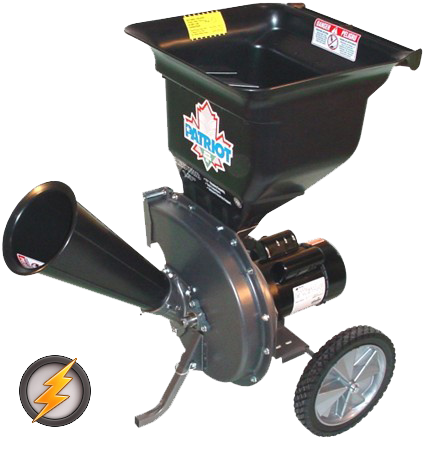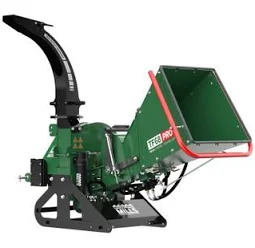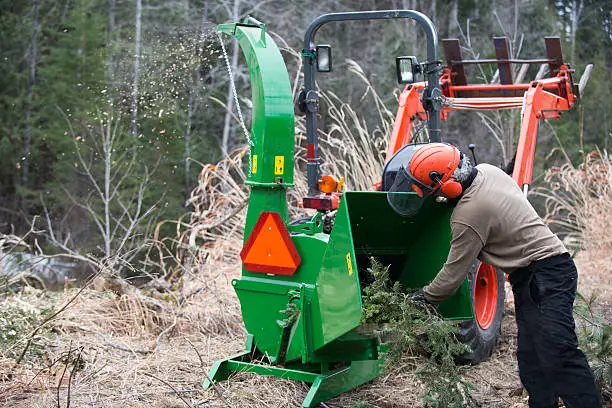Inside this Article:
What is a Wood Chipper? Understanding Its Function and Uses
A wood chipper is a machine designed to break down larger pieces of wood into smaller chips. It’s primarily used for clearing branches, twigs, and other debris from your yard, turning them into small chips that can be used for composting or as mulch.
The wood chipper’s main components include a rotating blade or drum, which helps break down the material, and a chute where the material is fed into. The size and power of the chipper can vary depending on the model and its intended purpose.
Types of Wood Chippers Available in the Market
Gas-Powered Wood Chippers
Gas-powered wood chippers are ideal for heavy-duty jobs. These chippers are robust, and they offer more power and flexibility, making them suitable for large yards with substantial tree trimming or clearing tasks.![]()
Electric Wood Chippers
Electric wood chippers are more compact and quieter than their gas-powered counterparts. These are perfect for lighter yardwork tasks, such as handling small branches and foliage.

PTO (Power Take-Off) Wood Chippers
These chippers are typically used for commercial purposes and are attached to a tractor for additional power. PTO wood chippers are highly efficient and ideal for large-scale operations.

How to Choose the Right Wood Chipper for Your Needs
Size of Wood and Branches You Plan to Chip
When choosing a wood chipper, it’s essential to consider the size of the branches you need to process. If you are working with large tree limbs, a more powerful gas-powered chipper may be necessary. However, for smaller branches, an electric model might be more convenient.
Budget Considerations
Your budget will play a crucial role in deciding which wood chipper to buy. Gas-powered chippers tend to be more expensive than electric models, so consider your yard’s needs and the frequency with which you’ll use the chipper.
Portability and Storage Needs
If you have limited storage space or need to move the chipper between job sites, portability will be an important factor. Electric models are often lighter, but gas-powered models can offer more power for large projects.
Step-by-Step Guide to Using a Wood Chipper Safely
Preparing Your Wood Chipper for Use
Before you begin, check the oil and fuel levels (for gas models) or ensure the electrical connections are in good condition (for electric models). Ensure the blades are sharp and properly aligned.
Safety Precautions to Follow
- Always wear protective gear, such as safety goggles, ear protection, and gloves.
- Ensure the area around the chipper is clear of obstacles.
- Never insert materials that exceed the recommended size.
How to Feed Materials into the ChipperStart by feeding small branches and twigs into the chipper. Avoid pushing large or thick branches in all at once. Always follow the manufacturer’s guidelines on the maximum branch diameter.
Common Mistakes to Avoid When Using a Wood Chipper
- Overloading the Chipper: Attempting to chip materials that are too large can damage the blades or motor.
- Not Following Safety Procedures: Neglecting safety measures can lead to injury.
- Improper Maintenance: Failing to maintain your chipper can result in inefficient performance and increased repair costs.
How to Maintain Your Wood Chipper for Longevity
Cleaning and Lubrication
After each use, clean out the chipper to prevent debris buildup. Lubricate moving parts to reduce wear and tear.
Sharpening and Replacing the Blades
Sharp blades ensure the chipper operates efficiently. Regularly check the blades and sharpen or replace them as needed.
Winterizing Your Wood Chipper
Before storing your chipper for the season, clean it thoroughly, change the oil, and store it in a dry, protected area to prevent rust.
Troubleshooting Common Wood Chipper Problems
Engine Won’t Start
This issue may be due to a dead battery, fuel issues, or problems with the spark plug. Check these components and replace or fix them as necessary.
Clogs and Jams
Clogs occur when the material being fed into the chipper is too thick or tangled. Always ensure that you’re feeding appropriate materials into the chipper.
When to Hire a Professional for Wood Chipper Repairs
If you’re unable to resolve issues on your own, it’s advisable to hire a professional technician. They can perform detailed diagnostics and repairs to keep your chipper running smoothly.
The Environmental Benefits of Using a Wood Chipper
Using a wood chipper not only helps maintain your yard but also provides an eco-friendly alternative to waste disposal. By turning branches and leaves into mulch or compost, you reduce landfill waste and improve the health of your garden.
FAQs About Using Wood Chippers
-
What size wood can a typical wood chipper handle?
Most wood chippers can handle branches up to 3-4 inches in diameter. Check the manufacturer’s specifications for exact measurements.
-
Can I use my wood chipper in wet conditions?
It’s not recommended to use a wood chipper in wet or damp conditions, as it can damage the machine or cause blockages.
-
How often should I change the oil in my gas-powered wood chipper?
Change the oil every 50 hours of use or once a year, whichever comes first.
-
How do I know when the chipper blades need sharpening?
If the chipper starts to struggle with material, or if it’s producing more dust than chips, the blades likely need sharpening.
-
Can I chip leaves and other yard waste?
Yes, wood chippers can handle leaves, but they are more efficient with woody material. Consider using a dedicated leaf shredder for optimal results.
-
Is it safe to use a wood chipper on my own?
Yes, as long as you follow all safety guidelines and use appropriate protective gear.

